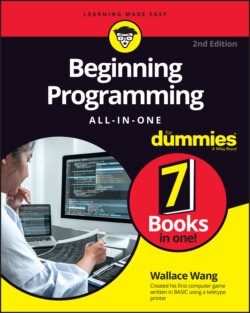Читать книгу Beginning Programming All-in-One For Dummies - Wallace Wang - Страница 11
Getting Started Programming a Computer
ОглавлениеIN THIS CHAPTER
Understanding how computer programming works
Diving into the history of computer programming
Discovering programming
Believe it or not, if you can write a recipe on an index card, you can program a computer! At the simplest level, computer programming is nothing more than writing instructions for a computer to follow, step-by-step. The most important part of programming isn’t knowing how to write a program or how to use a particular programming language, but knowing what to create in the first place.
Some of the most popular and useful computer programs were created by people who didn’t have any formal training in math or computer science. Dan Bricklin invented the spreadsheet while studying for his MBA at Harvard. Scott Cook, who worked in marketing and product development at Procter & Gamble, created the popular money-management program Quicken after hearing his wife complain about the tedium of paying bills. Nineteen-year-old Shawn Fanning created Napster, the first peer-to-peer file-sharing network, after hearing a friend complain about the difficulty of finding his favorite songs on the Internet. Game developer Dona Bailey wanted to create a video game that would appeal to both men and women; as the only woman working at Atari’s coin-op division, she created the video game Centipede, which became Atari’s second best-selling coin-op game.
The point is that anyone can figure out how to program a computer. What’s more important than knowing how to program a computer is knowing what to do with your programming skills. As Albert Einstein said, “Imagination is more important than knowledge.” After you have an idea for a program, you can use programming to turn your idea into reality.
